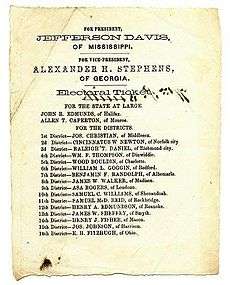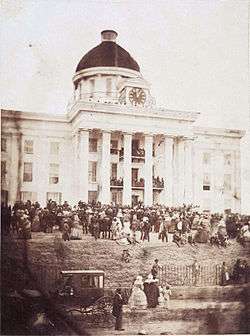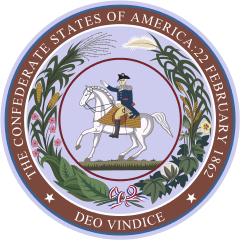President of the Confederate States of America
| President of the Confederate States of America | |
|---|---|
|
| |
| Style | His Excellency |
| Member of | Cabinet |
| Residence |
|
| Seat |
|
| Appointer | |
| Term length |
|
| Formation |
|
| First holder | Jefferson Davis |
| Final holder | Jefferson Davis |
| Abolished | May 10, 1865 |
| Deputy |
Vice-President of the Confederate States |
| Salary | CS$25,000 per annum |
The President of the Confederate States of America was the elected head of state and government of the Confederate States. The president also headed the executive branch of government and was commander-in-chief of the Army and Navy, and of the militia of the several states when called into Confederate service.[1]
Article II of the Confederate States Constitution vested the executive power of the Confederacy in the president. The power included the execution of law, alongside the responsibility of appointing executive, diplomatic, regulatory and judicial officers, and concluding treaties with foreign powers with the advice and consent of the senate. He was further empowered to grant reprieves and pardons, and convene and adjourn either or both houses of congress under extraordinary circumstances.[1]
The president was indirectly elected by the people through the Electoral College to a six-year term, and was one of only two nationally elected Confederate officers, the other being the Vice President of the Confederate States. On February 18, 1861, Jefferson Davis became president of the provisional government. On February 22, 1862, he became president of the permanent government and served in that capacity until being captured by elements of the United States Cavalry in 1865.[2]
Powers and duties
The constitutional powers of the President of the Confederate States of America were quite similar to those of the President of the United States of America. The permanent Confederate States Constitution made him commander-in-chief of the Army and Navy, and of the militia of the several states when called into service of the Confederate States. He was also empowered to grant reprieves and pardons for offenses against the Confederate States. He was authorized to make treaties; to nominate and appoint diplomatic representatives, judges, and other officers of the Confederate States (including the heads of the executive departments) by and with the consent of the Confederate States Senate; and to remove such representatives and officers. He could fill vacancies during a recess of the Senate, but he could not reappoint, during a recess, persons previously rejected by it. He was to supply Congress with information, recommend legislation, receive ambassadors and other public ministers, see that the federal laws were faithfully executed, and commission all officers of the military and naval forces of the Confederate States.[2]
Election and oath


On February 9, 1861, the provisional congress at Montgomery elected Jefferson Davis president and Alexander H. Stephens vice president. Stephens, who was a delegate to Congress from Georgia, was inaugurated on February 11. Davis was inaugurated on February 18 upon his arrival from Mississippi, where he had gone upon his resignation from the U.S. Senate. Davis and Stephens were elected on November 6, 1861, for six-years terms, as provided by the permanent constitution. The Capital had been moved in June 1861, to Richmond, and the inauguration took place at the statue of Washington, on the public square, on February 22, 1862.[2]
Before Davis entered on the execution of his office as President of the Confederate States, he was constitutionally required to take the following oath or affirmation:
"I do solemnly swear (or affirm) that I will faithfully execute the office of President of the Confederate States, and will, to the best of my ability, preserve, protect, and defend the Constitution thereof."[1]
Compensation
In 1861, the President of the Confederate States earned a CS$25,000 annual salary, along with an expense account, and a nontaxable travel account.[3] The President's Office was located on the second floor of the Custom House on Main Street, a structure which also housed the Cabinet Room and the State and Treasury Department. The City of Richmond purchased the Brockenbrough house for presentation to the Confederate government for use as an executive mansion. Davis declined to accept the gift, but the mansion was leased for his use. Referred to as the "White House of the Confederacy" or the "Grey House," the mansion was used by President Davis throughout the existence of his presidency. Later it became a repository for documents, relics, and pictures, and in 1896 it was redesignated the Confederate Museum.[2]
Post-presidency
Late on the evening of April 2, 1865, President Davis, his aides, and members of the Cabinet, except Secretary of War Breckinridge, departed from Richmond on the Richmond and Danville Railroad. The Cabinet stayed at Danville, 140 miles (225 km) southwest of Richmond, until April 10, when, hearing of Lee's surrender, it continued farther south. At Greensboro, North Carolina, on April 12 the Cabinet met with Generals Johnston and Beauregard and discussed surrender of Johnston's army to General Sherman. As the railroad south of Greensboro had been destroyed, the flight from that location was on horseback and in ambulances, wagons, and carriages. The last Cabinet meetings took place at Charlotte, on April 24, and 26, and on May 4; when Davis left Washington, Georgia, the party consisted only of his aides and Postmaster General Reagan. Elements of the United States Cavalry captured Davis and his companions at an encampment near Irwinville, May 10, 1865.[2]
Jefferson Davis was imprisoned at Fort Monroe, Virginia, until his release on bail on May 13, 1867. During his confinement the United States Government prepared to bring him to trial for treason and for complicity in the assassination of United States President Abraham Lincoln. He could not be tried in Virginia until the Federal court was reestablished there, but by the time the circuit judges were prepared in May 1867 the United States Government decided the outcome of a trial before a local jury was far too uncertain and dropped the proceedings. In November 1868 Davis was brought to trial under a new indictment, but the judges disagreed and the case was referred to the Supreme Court. President Johnson issued a general amnesty in December 1868, and the Supreme Court entered a nolle prosequi, thus freeing Davis.[2]
List of presidents
| № | Portrait | President | State | Term of office | Party | Term | Previous office | Vice President | ||
|---|---|---|---|---|---|---|---|---|---|---|
| 1 |  |
Jefferson Davis June 3, 1808 – December 6, 1889 (Aged 81) |
Mississippi | February 18, 1861 [n 1] – May 10, 1865 |
Non-partisan | 1 (1861) |
U.S. Senator from Mississippi (1857–1861) |
Alexander H. Stephens | ||
See also
- Jefferson Davis Presidential Library and Museum
- Vice President of the Confederate States of America
- Congress of the Confederate States
- Postage stamps and postal history of the Confederate States
- Treatment of slaves in the United States
Notes
- ↑ Jefferson Davis initially took an oath of office as President of the Confederate States of America on February 18, 1861 in Montgomery, Alabama, under conditions set forth in the Constitution of the Provisional Government. After being directly elected to the presidency, he took another oath of office (this time for a six year term) on February 22, 1862 in Richmond, Virginia, as prescribed in the "permanent" Constitution of the Confederate States.
References
- 1 2 3 C.S. Congress (provisional) (May 1861) [1st pub. March 1861]. "Article II". C.S. Constitution. Constitutional Convention. Syme & Hall, Printers to the Convention.
- 1 2 3 4 5 6 Beers, Henry Putney (2004) [1st pub. United States Government Publishing Office:1968]. "Chapter IV: The Presidency". The Confederacy: A Guide to the Archives of the Government of the Confederate States of America. Washington, D.C.: National Archives and Records Administration. pp. 62–71. ISBN 0-911333-18-5 – via National Archives Trust Fund Board.
- ↑ Vanfelson, C. A. (1861). The Little Red Book or Department Directory: For the Use of the Public in the Confederate States of America. Richmond: Tyler, Wise and Allegre, Printers. p. 4. OCLC 52558640 – via Enquirer Job Office.
Further reading
- Henry, Robert Selph (1931). "Chapter VII: Government, Provisional and "Permanent"". The Story of the Confederacy (1st ed.). Garden City, New York: Garden City Publishing Company. pp. 88–99. OCLC 1300151 – via The Bobbs-Merrill Co.
- McPherson, James M. (2014). Embattled Rebel: Jefferson Davis as Commander in Chief. New York: The Penguin Press. ISBN 978-1-59420-497-5. OCLC 870248703.

